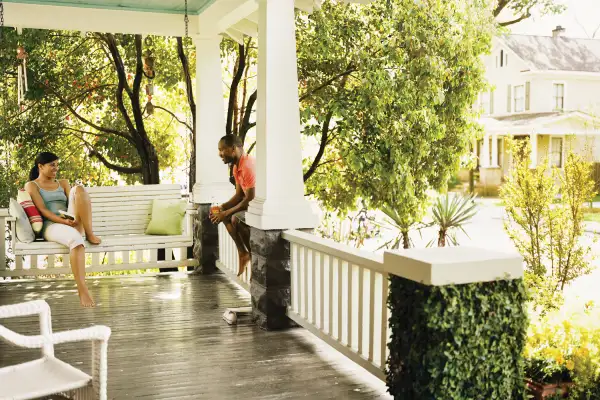What Everyone Gets Wrong About Millennials and Home Buying

If you've come across any stories mentioning millennials and home ownership, you've likely heard this refrain: Young people just aren't very interested in buying a house. Instead, the story goes, they want to rent a cool apartment, live in a city, and walk to coffee shops. Forever.
This narrative was eloquently expressed in a recent New York Times article about a hip, 30-year-old, unmarried couple choosing to rent in a swanky Virginia high-rise. What made these millennials pick a rental apartment over a nest of their very own? The developer of the couple's new home, Joshua Solomon, had his theories:
“That generation of folks has seen people really get hurt by homeownership,” said Mr. Solomon, president of the company, which is based in Waltham, Mass. “The petal has really fallen off the rose as it pertains to homeownership. People don't want to be tied down to a mortgage they can't get out of quickly.”
Sounds like a reasonable conclusion, right? Multi-unit construction is up, after all, and first-time home buyers are in historically short supply.
But if you dig a little deeper, both Solomon's generalization and the "millennials don't really want to own homes" trope turn out to be largely untrue. A number of surveys have shown that the vast majority of millennials would love to own a place of their own. Recent research from housing site Zillow, for example, found that adults age 22 to 34 are actually more eager to own a home than older Americans.
According to Zillow's data, young married couples in which both partners work (represented by the orange line in the left graph below) currently own homes at a rate close to or above historical norms for their demographic. Even single employed millennials (the yellow line in the right graph) are slightly more likely to own a home than their counterparts in the '70s, '80s, and '90s.
So if young adults want homes more than previous generations, why is their homeownership rate at a historic low? The answer is that millennials are getting married later in life, and not having two income streams makes it much harder to scratch together a down payment.
From 1960 to 2011, Americans' median age at the time of their first marriage increased by six years, to around 29 from 23 for men and 26 from 20 for women, according to Census data. Then came the financial crisis, which pushed marriage back even further by making financial stability—a marital prerequisite for many— a rarity among recent college graduates. According to one recent study from the University of Arizona, only about half of adults ages 23 to 26 and at least one year out of college have a full-time job.
As a result, the millennial generation's overall home purchases are down—but they probably won't be down forever. Zillow's analysis shows that if millennials were marrying at the same pace as previous generations, their rate of homeownership would be 33%, six percentage points higher than now and roughly the same as in the 1990s. Once this generation begins to tie the knot, the evidence suggests, it'll be buying homes at least as frequently as older Americans once did.
Old School Values
In fact, there's some evidence that home ownership is more important to millennials than it is to Gen Xers or boomers. In a recent survey, forty-six percent of respondents ages 18 to 34 told Zillow they believe "owning a home is necessary to being a respected member of society," and 65% said "owning a home is necessary to live The Good Life and The American Dream." Both results were higher (in most cases, significantly higher) than older age groups.
America's newest generation—post-millennials—are perhaps the most old-fashioned of all. A shocking 97% of teens age 13 to 17 believe they will one day own a home, and 82% say homeownership is the most important part of the American dream. If anything, buying a home seems to be getting more attractive, not less.
So millennials really want a home, but they still want a cool home, right? One that's urban, and different, and close to a Blue Bottle Coffee? Maybe when they're still young and single, but a large amount of evidence suggests that even today's young adults look to the suburbs once children come along. Highly dense "core cities" like San Francisco and New York are attractive to millennials looking for fun and adventure, but they're also extremely expensive to live in when dependents enter the picture.
Research suggests a negative correlation between big cities and child populations. City Journal found that between 2000 and 2010, the population of children 14 and younger fell by 500,000 in the country's densest urban areas, including Los Angeles, Chicago, and New York. As children disappeared from cities, the nation's 51 largest metro areas lost 15% of adults 25 to 34—the same age range when many begin to marry and start families. "While it’s not possible to determine where they went," the Journal noted, "suburbs saw an average 14 percent gain in that population during the same period."
Mollie Carmichael, principal at John Burns Real Estate Consulting, is already seeing millennials flee cities to more child-friendly environments. "We do find that the millennials want to be in urban areas, but usually when they're not married and they're renting" says Carmichael. "But the trigger is marriage, and then frankly they want more traditional areas and more traditional environments than even their parents. They want suburban; they want single-family detached; they want a yard."
What about millennials' much-reported fixation on urban-ness? There's some truth to it, Carmichael acknowledges, but "urban to them means they want the ability to walk to the park and walk to the Starbucks. It's more about accessibility, and that could be driving to those great places they want to go."
In the end, America's newest adult generation isn't that different from the previous ones. Millennials may Instagram their new home instead of sending photos through the mail, but not much else has changed.
